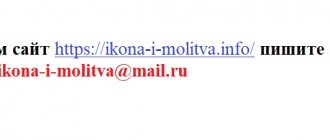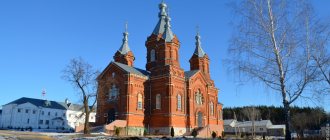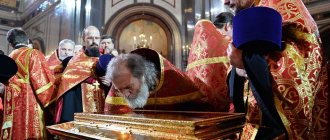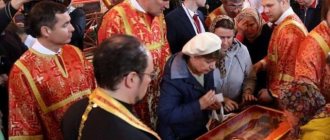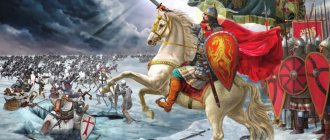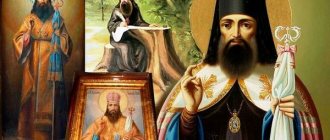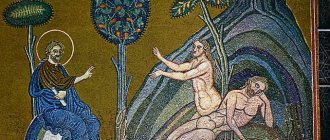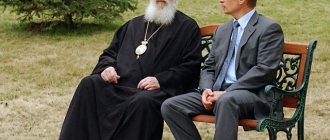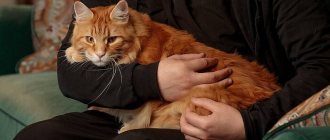Patriarch Tikhon died in 1925. He was buried in the Small Cathedral of the Moscow Donskoy Monastery, writes pravoslavie.ru. And after some time, people were found who reported that the body of the patriarch was secretly taken out of the monastery.
The publication pravmir.ru quotes the words of archaeologist Sergei Belyaev:
“Everyone was sure that the place that <...> is designated as a grave is nothing more than simply a designation of the place where the patriarch was once buried. Because there were witnesses to how on one of the winter nights in the early 30s <…> a sleigh with a coffin drove off towards the crematorium.”
Believers were almost sure that the body of Patriarch Tikhon was destroyed, and not simply transported to another place. After all, the patriarch’s activities ran counter to the interests of the Soviet government. In the issue of Izvestia dated March 28, 1922, he opened a list of enemies of the people “with his entire church council.”
Winter. Religion.
Mikhail Khaustov
Relations between Patriarch Tikhon and Soviet power
In 1918, the patriarch wrote a letter to all Orthodox Christians, where he anathematized (cursed) the atheists. He forbade those who participate in persecution of faith from participating in church sacraments. Patriarch Tikhon stated that for cruel acts they are subject to “the fire of Gehenna in the future life - the afterlife and the terrible curse of the offspring in the present life - earthly.”
When the campaign to destroy the relics of Orthodox saints began, the patriarch made statements to Lenin and Kalinin. According to him, such treatment of shrines not only offended the religious feelings of believers, but also violated the Constitution of the RSFSR.
In 1922, when a terrible famine began in the country, Patriarch Tikhon of Moscow allowed churches to donate church valuables (except for those needed for divine services) to help the hungry. After some time, the authorities adopted a decree that any church valuables would be forcibly confiscated. The Patriarch publicly spoke out against the confiscation of consecrated objects. After this, a case was opened against him, and the head of the church was put under house arrest. He was in captivity for about a year, writes portal-slovo.ru.
Church. Prayer.
CC0
“Churchmen hinder the building of communism”
The rector of the Epiphany Cathedral, Archpriest Nikolai Karasev, died a month after the examination of the relics, when the new “anti-relic” campaign was just gaining momentum.
They say my heart couldn't stand it. The first rumble of thunder was enough for him. The anti-religious element was in full swing in Orel in 1960. The keymaster of the cathedral, Archpriest Alexy Belyaev, found himself in the epicenter of two scandals at once. On May 1, during the Baptism of a one and a half month old baby, which was performed by Father Alexy, a tragedy occurred. The person being baptized (Seryozha Sirotin) died. The Orlovskaya Pravda newspaper responded to this event with a devastating publication, “Murder in the Name of God.” But neither law enforcement agencies nor the clergy found the priest guilty. However, after the promotion of the story with the relics of St. Tikhon and new publications in the press, Archpriest Alexy Belyaev had to leave the Oryol diocese and look for places in the Vladimir region. He was not banned from serving and, moreover, he was not defrocked.
During the era of Khrushchev’s persecution of the Church, a phenomenon was observed that was aptly called the “parade of renegades.” Oryol also had its renegades. Vasily Okolovich, who served in the Epiphany Cathedral from 1942 to 1959, stated that there are simply bones in the temple and “there is no guarantee that these bones belong specifically to Tikhon’s skeleton. Such bones can be found in any grave."[8] And in general, according to the former priest, “this props was made only for the purpose of personal enrichment of clergy”[9].
Orlovskaya Pravda correspondents V. Bakaev and I. Mikhailov wrote a long article “A lie sewn with white thread.” They called for remembering the order of the workers' and peasants' government of 1920 and, “based on the insistent demands of the working people,” proposed to transfer the relics to the museum.
The article by Oryol authors was reprinted in the Zadonsk regional newspaper “For the Victory of Communism.” Similar articles appeared in the central press: the newspaper “Soviet Russia” and the magazine “Crocodile”. The “demands of the workers” were not long in coming.
The communist labor team of the tractor spare parts plant sent an angry letter to the chairman of the executive committee of the Oryol Regional Council of Deputies. The letter expressed protest against “the new fraudulent methods of church ministers” [10]. “These churchmen are preventing us from working, building communism, fighting for peace,” the brigade was indignant as one person. – The new fuss with the “incorruptible” knuckles of some Tikhon is an evil attempt by the churchmen to give us, the Soviet people, the builders of a new society, a fight... There is no place for these church things in the glorious, fighting city of Orel! ...Get them out of Orel and the Oryol region!”[11].
N. Zverev, Commissioner of the Council for the Affairs of the Russian Orthodox Church in the Oryol Region, also responded to the publication in the newspaper. On August 4, 1960, he asked the Moscow authorities for “instructions on the measures that should be taken to eliminate the “relics””[12]. They responded from Moscow: “The issue of liquidating the “relics” of Tikhon Zadonsky should be considered by local authorities. We shouldn’t interfere in this matter.”[13]
Workers of the Oryol Local History Museum showed interest in the relics, turning to local secular and church authorities with a request to return this “exhibit” to them. On September 23 of the same year, N. Zverev, executing the order of the Executive Committee of the Oryol Regional Council of Workers' Deputies, transferred the relics of St. Tikhon to the director of the museum, “Comrade. Koreneva"[14]. Which is what he reported to the prosecutor of the Oryol region. In a letter to Bishop Jerome of Oryol, Zverev recalled that there was no permission from the Soviet authorities to return the relics from the museum to the church.
Thus, the relics of the Zadonsk saint, contrary to the demands of the communist labor brigade, remained in Orel. But the third participant in the examination of the relics, Priest Vladimir Ott, had to leave this city.
Where did the relics of Patriarch Tikhon go?
After the death of Patriarch Tikhon of Moscow, none of the believers could say exactly what happened to the body of the head of the church. There were various rumors surrounding the disappearance of the relics, reports pravoslavie.ru
According to one of them, by order of the authorities, back in 1927, the body of Patriarch Tikhon of Moscow was pulled out of the grave and burned. According to another version, the monks secretly reburied the body. People assumed that the relics rested either in the German cemetery in Lefortovo (now the Vvedenskoye cemetery in Moscow) or in the necropolis of the Donskoy Monastery.
Snow. Winter.
Mikhail Khaustov
One of the community of Elder Alexy of Moscow
Vladimir Vasilyevich Ott took holy orders in 1953. Behind him was an unfinished higher education and two prison terms (a total of 13 years), which he completely served in the harsh northern region. Born in Moscow at the dawn of the 20th century into a German Lutheran family, the future confessor and mitred archpriest Vladimir Ott gained faith and wholeheartedly accepted Orthodoxy after the outbreak of the revolution. That is, at a time when many Russian people cowardly retreated from the Church and fearfully renounced Christ.
Vladimir Ott grew spiritually in the community of the famous Moscow elder Archpriest Alexy Mechev, who served in the Church of St. Nicholas on Maroseyka and is now glorified among the saints. After the death of the holy righteous Alexy of Moscow, Vladimir, who bore the obedience of a reader, was cared for by his father’s son, Archpriest Sergius Mechev. The name of the Hieromartyr Sergius is also in our calendar. In 1929, the authorities took the Marosei community seriously. The rector was arrested. The reader was also arrested.
Between two terms (from 1933 to 1937), Vladimir Ott lived in Orel with his wife Anna and their newborn son. He returned here from the camp in 1947, but he was forbidden to settle in the city. As a former prisoner, Vladimir Vasilyevich lived in a rural area. In 1952, he lost his beloved wife. And a year later - a job, since the office in which he worked was liquidated. No matter how hard it was for Father Vladimir, the first loss did not break him, and the second did not sadden him. He took the deprivation of civilian work as a sign that the time had come to work for the Lord.
Until Vladimir’s father’s criminal record was cleared, there was a ban on living in the regional center. On November 30, 1954, the priest dared to write a statement addressed to K.E. Voroshilov, who at that time was the Chairman of the Presidium of the Supreme Soviet of the USSR. And on October 8 of the following year, the Oryol Regional Court overturned the decision of the Troika under the NKVD in the Oryol Region, according to the verdict of which Father Vladimir served 10 years in the camps.
In 1958, the bishop transferred Priest Vladimir Ott from the village of Shakhovo to Orel, appointing him rector of the Afanasyevskaya Church. This wooden church, which burned down in the 1990s, was located in a cemetery not far from the former Vvedensky Convent. According to the nuns of the revived monastery, priest Vladimir Ott was in those years the keeper of a locally revered shrine - the Balykino Icon of the Mother of God.
After the story with the relics of St. Tikhon of Zadonsk, Father Vladimir was sent on leave in order to find a new place of ministry. Probably, the widowed priest was thinking about taking monastic vows, which is why he went to the Glinsk Hermitage. But the authorities were preparing to close this monastery, and the tonsure did not take place.
The persecuted priest was accepted into his diocese by Bishop Leonid (Polyakov) of Kursk. The Bishop warned that he would not be able to give Father Vladimir a place in the city church for now, and was forced to hide him in the village. So in 1960, the priest turned out to be the rector of the Church of the Znamenskaya Icon of the Mother of God in the village of Zhukovo near Stary Oskol. And a year later, when passions had subsided slightly, priest Vladimir Ott became rector of the Ilyinsky Church of the Ezdotskaya settlement, which soon became part of the city of Stary Oskol. Here the priest rested 30 years later, “in old age with mastitis,” having celebrated his 91st birthday.
How did you manage to find the relics of the patriarch?
In 1989, at the Council of Bishops, Patriarch Tikhon was canonized (canonized). But even having made such a decision, the church hierarchs did not raise the issue of the holy relics of the patriarch.
In 1991, a fire occurred in the Small Cathedral of the Donskoy Monastery. A Molotov cocktail was thrown inside the temple. The temple was seriously damaged by fire; most of the floor had to be opened. And there, at the bottom of the crypt, they found an oak coffin with a marble tablet on which was written: “Patriarch of Moscow and All Russia Tikhon.”
On February 22, representatives of the Holy Synod arrived at the Donskoy Monastery, the solemn discovery of the relics took place: the coffin was lifted from the crypt and placed in the temple, writes moseparh.ru. A few more days later, the archbishop and his assistant washed the relics and changed clothes.
Now believers can venerate the relics of Patriarch Tikhon of Moscow in the Great Cathedral of the Donskoy Monastery, clarifies Thomas.
Relics of Saint Tikhon
Chapter from the book “Unholy Saints and Other Stories”
Discovery of the relics of Patriarch Tikhon in the Donskoy Monastery
One of the mysteries of church life in Soviet times was the fate of the relics of St. Patriarch Tikhon, buried in 1925 in the Small Cathedral of the Moscow Donskoy Monastery. In 1946, at a memorial service at his tomb, Metropolitan Nikolai (Yarushevich) of Krutitsky and Kolomna said with sadness: “We prayed now only over the grave of His Holiness. His body is not here."
There was every reason for such confidence. The fact that the remains of Patriarch Tikhon could be destroyed did not surprise anyone: if the Orthodox treated the deceased head of the Russian Church as a saint, then the hatred of him on the part of the Bolsheviks was exceptional even against the backdrop of frenzied Soviet atheism. In the list of enemies of the Soviet regime, published in one of the issues of the Izvestia newspaper, Patriarch Tikhon was listed as number one.
According to rumors, in 1927, after the closure of the Donskoy Monastery, the authorities, fearing that the relics of the Patriarch would become an object of worship, removed his coffin from the grave and burned it in the crematorium. According to other sources, the remains of His Holiness were secretly taken out by monks and buried in the German cemetery in Lefortovo. Supporters of the third version argued: realizing that the authorities could abuse the remains of the Patriarch, the monks, soon after the burial, reburied them somewhere in the necropolis of the Donskoy Monastery.
These assumptions grew into real conviction when, in 1932, the leader of the church schismatics-renovationists, supported by the Soviet government, “Metropolitan” Alexander Vvedensky, suddenly appeared before his admirers in bishop’s robes, which Muscovites immediately recognized as precious vestments, sewn especially for Patriarch Tikhon at the famous merchants’ factory Olovyanishnikov brothers. Patriarch Tikhon was buried in them.
And yet the hope that the relics of the Patriarch, beloved by the entire Church, would one day be found remained.
***
When monastic life began to be revived in the Donskoy Monastery, one of the first requests that the then small brethren of the monastery addressed to their abbot, Patriarch Alexy II, was a request to search for the relics of St. Tikhon. His Holiness joyfully blessed us for these works. If only we knew then what incidents this would be connected with and how wonderfully everything would end!
Soon an opportunity presented itself. Renovations have begun in the Small Cathedral of the Donskoy Monastery. The temple was closed for several months, and at this time the search would have started... but under various pretexts they were postponed, and now the repairs were already completed. Services resumed in the church, but time was lost. And to be honest, we then frivolously and very stupidly neglected the patriarchal blessing, citing various “reasons and circumstances.” For which they paid. And very soon. Although, as always, the Lord guided our mistakes to the common understanding and to the triumph of His faithful holy new martyr Patriarch Tikhon.
It was November 1991. The governor, Archimandrite Agathodorus, having finished the repairs, went on a service trip and left me in charge of the monastery. There weren’t too many worries if it weren’t for the annoying conflict with some strange people who fell on our heads. They presented themselves as priests and laity of the Russian Church Abroad, although, as it later turned out, they had nothing to do with it. With scandals and outrages, they tried at all costs to organize their divine services in the monastery without the blessing of the Patriarch. We persuaded and exhorted them as best we could, and finally, realizing that nothing was helping, we decisively pushed the uninvited guests outside the fence. But they harbored a grudge.
November 18 marked the day when, in 1917, at the Local Council, St. Tikhon was elected Patriarch of All-Russia (the lot then fell on him, one of three candidates). I was sick, but still served the liturgy that day, and then the memorial service: it was also the anniversary of the death of Father Rafail (Ogorodnikov). In general, November 18 is an extraordinary date for me. In 1988, on this day, Father Raphael died, and in 1993, Valentina Pavlovna Konovalova, the “Moscow merchant’s wife,” the spiritual daughter of Father John, died. The story I am telling about also happened on November 18th. But this is by the way.
At the liturgy, for the first time in my priestly life, I prepared spare Holy Gifts for communion with the sick. Although according to church rules this is done on Maundy Thursday, the night before my friend, the sculptor Vyacheslav Mikhailovich Klykov, came to me with a request to urgently administer Holy Communion and Unction to a sick acquaintance. However, it turned out that there are no spare Holy Gifts in our church: it turns out they were never prepared here.
Thank God, everything turned out well with Klykov’s friend. That night I administered unction to him, and the next morning the sick man was given communion by a priest from another church. To prevent this from happening again, under the guidance of our old hieromonk Father Daniel, I prepared spare Holy Gifts and placed them in a special ark on the throne.
After the evening service, my friend Zurab Chavchavadze came to visit me with a jar of raspberry jam. We were drinking tea when the duty officer called and reported with alarm that several fire crews had arrived at the gate and their commander assured us that they urgently needed to put out some kind of fire in our area.
— Is something burning here? - I was surprised.
- Of course not! — the duty officer reassured me. “It’s probably their commander who’s burning inside...
I got it. Not far from us there was a fire department, whose leadership was friends with Father Agathodor. One of the officers was a big fan of sitting with the priest at the table and philosophizing about life. Once, during a period of such philosophical and alcoholic exacerbation, he was already eager to go to the monastery in the middle of the night. Now, apparently, history was repeating itself.
I hung up, but a minute later the call rang again. The duty officer reported that the firefighters were not letting up. This was too much. Zurab and I had to get dressed, and I also had to wrap myself up warmer after the raspberry jam, and go figure things out.
- What's happened? - I shouted so that it could be heard outside the gate.
- Fire! You're on fire! - came from there.
- Maybe you can come up with something more fun? – I asked sarcastically.
- We received a call! – they didn’t let up on that side.
“This is some kind of mistake, you can see for yourself,” I answered, still opening the gate.
There were indeed two fire engines with full crews standing at the monastery walls. Several people in shiny helmets entered the monastery. They themselves were at a loss.
— A woman called, we thought it was from you. She said: there is a fire in Donskoy, leave urgently.
To finally make sure that there was a misunderstanding, I suggested we walk around the monastery together. We headed towards the central square. It was already late twilight, but everything was clearly visible. The usual peace and quiet, nothing caused alarm.
“You see,” I smiled and turned to the firefighters.
And at that moment, a bright flash flashed in the windows of the Small Cathedral of the Donskoy Monastery, the sound of breaking glass was heard, and an orange flame with clouds of black smoke burst out of the window frames.
Firefighters rushed to their engines. And Zurab and I froze with our mouths open. Then they shouted like crazy:
- Fire!!! Fire!!! - And they rushed to the temple.
Fire trucks roared past us. But the temple was already in full flames. The fire raged in the window openings, smoke rose in a gloomy billowing column into the Moscow evening sky.
I will not describe this terrible night for a long time. Only at three o'clock did the firefighters allow us to enter the temple. What appeared before our eyes was truly terrible. Black walls and ceiling, charred shrines, icons, everything is flooded with water, an unbearable smell of burning...
One of the firefighters called me to follow him deeper into the temple and along the way he voiced his first conclusions about the cause of the fire. The fire started, as he claimed, right at the tombstone of the Patriarch. Since the walls of the temple were painted with flammable oil paint, the flames spread instantly.
“But this is really strange,” said the fireman, pointing to the iconostasis.
Although the wooden chapels and icons were blackened by soot, they were not even charred. The iconostasis has been completely preserved. With a sinking heart, I entered the altar and saw that here, too, except for soot, nothing had been touched. When I returned to the officer, he explained his bewilderment to me.
“Everything next to the iconostasis is burned out, but for some reason it itself is intact. It's wooden, not metal?
— A very old tree.
- How come it didn’t burn? Marvelous…
Then I remembered and said:
- Ah!.. We placed the Holy Gifts on the throne this morning!
- They put what?
I tried to explain. The officer listened politely and, clearing his throat, asked:
- Do you seriously think that this has something to do with keeping the tree safe from fire?
- Don't know. I'm just saying that in the morning we placed the Holy Gifts on the throne.
“M-mm... I see,” the officer said incredulously. - However, this happens sometimes. Everything around is burning, but some objects remain. In our business, everything happens.
The investigation began on the same day. It turned out that the fire actually started near the tomb of St. Tikhon. The window here is always kept ajar, and, as investigators suggested, the attacker threw a simple petrol bomb into the temple. The walls, painted with oil paint, immediately began to work. Moreover, the criminal had enough time to leave the monastery unnoticed, with the last visitors.
The circumstances due to which the fire was discovered so quickly were also revealed. One of our parishioners, who lives opposite the Donskoy Monastery, used to read evening prayers on the balcony. It was she who saw the flash in the window of the temple and immediately called the fire department.
A day later, we served an all-night vigil in memory of the Archangel Michael in the burnt cathedral. The choir sang “Praise the name of the Lord,” I performed the festive incense, and people, standing among their relatives, walls blackened by soot and arks burnt to the hilt, could not hold back their tears. We did not want to move the service to another monastery church: we could not allow people to think that this difficult test was simply a game of blind chance and the Lord would not turn our confusion and sorrow into joy, into the triumph of faith and hope in His all-good Providence, incomprehensible to us. This is exactly what I spoke about that evening in my sermon to our parishioners.
It was necessary to begin repairs in the temple. We served here for less than a week after the restoration, and now the Lord again provided us with the recently missed opportunity to begin the search for the relics of St. Tikhon.
We turned to His Holiness again, and he confirmed his blessing for the excavations, only instructing us to act carefully and prudently. We understood his concern. Some people generally tried to persuade the Patriarch not to allow the search, since the possibility of finding the remains of the saint was very small. But if a rumor spreads that they were looking for the relics of Patriarch Tikhon and did not find them, then, cautious advisers warned, there will be no problems: schismatics and ill-wishers of the Church will immediately spread the rumor that Saint Tikhon himself did not want to have his relics in the Patriarchal Church. But, thank God, Patriarch Alexy firmly said: if we find the relics, there will be a great holiday; if they are not there, we will not hide it from anyone.
The people who committed the arson were never found. The brethren of the monastery and some parishioners imagined who it could be, but they even somehow pitied them and in their souls handed them over to the merciful court of God. Moreover, now, with the passage of time, it is clear how providentially this atrocity was allowed to happen. It was during the second, protracted renovation of the Small Cathedral of the Donskoy Monastery that the relics of the saint were discovered.
In the evening on the feast of the Presentation of the Lord, we performed a prayer service at the tomb of Patriarch Tikhon and began excavations. Few knew about this: His Holiness Patriarch Alexy II, several monks, two elders - Archimandrite Kirill from the Holy Trinity Sergius Lavra, Archimandrite John from the Pskov-Pechersky Monastery and those whom we asked to help us: Vyacheslav Mikhailovich Klykov with his apprentices and the artist Alexey Valerievich Artemyev. We were led by archaeologist Sergei Alekseevich Belyaev. Previously, he took part in the discovery of the relics of St. Ambrose of Optina, and was engaged in excavations in Diveyevo and Chersonesos.
First, the tombstone was removed. Its marble became almost brown after the fire. Having gone thirty centimeters deeper, we discovered a massive marble slab with the inscription: “His Holiness Tikhon, Patriarch of Moscow and All Russia.” This was precisely the title of Russian Patriarchs at the beginning of the twentieth century. The find greatly inspired us. We began to dig further and at a depth of about a meter we saw what we were looking for - the stone vault of the crypt. Taking up the work with tripled energy, by morning we carefully cleared the entire crypt. When I managed to remove several stones from the vault, I inserted a lit candle into the resulting hole and looked inside. The crypt was empty. The candlelight caught only dusty shreds of old cobwebs.
When I announced this to my friends, everyone, exhausted, sank to the floor in all directions and, with their heads down, sat in silence for some time. Then one after another they rushed to check: what if I was mistaken, maybe there were at least particles of relics or chips of the coffin left in the vast crypt, dropped during the opening of the Patriarch’s grave? However, nothing, nothing happened... Our worst fears were justified.
Having come to our senses a little, we decided to at least document the size and condition of the crypt. But when someone began to measure its length, the two-meter-long rod unexpectedly completely went both to the right and to the left. The same thing happened with the eight-meter rod. We hastened to explore the underground structure and soon realized that we had not discovered a crypt, but part of the temple’s heating system - stone pipes located under the floor, through which hot air from the furnace passed. For some reason, at the site of the Patriarch’s grave, the heater was significantly expanded, so that a semblance of a crypt actually formed. And the masonry here looked new compared to other parts of the stone underground pipe. Perhaps it really was a ruined crypt. But perhaps the grave was located much deeper. And what we discovered was a false crypt, designed to confuse the Bolsheviks and lead them to believe that the coffin with the body of the Patriarch had already been removed and reburied somewhere.
And then Father Daniel brought one old man who claimed that he supposedly knew for certain: St. Tikhon was buried five meters east of his supposed tomb. Opinions were divided, and the next morning we went to His Holiness to ask for blessings on what to do next. Having found out all the details, the Patriarch gave his blessing to continue the search in the same place.
Finally, closer to night, the real crypt of the Patriarch appeared before us. There was no doubt about it. It was a powerful structure, covered with a huge slab, which, fortunately for us, turned out to be not solid, but consisting of several massive stone sections. We picked up one of these boulders. I lay down on my stomach and lowered the candle inside. I remember being immediately struck by the aroma of spring freshness emanating from the underground tomb. Everyone crowded around. In front of me was a fine, exquisitely carved oak coffin, the description of which I knew well. On it lay a marble tablet. As the candle flickered, I read: “Patriarch of Moscow and All Russia Tikhon.”
We couldn't believe our luck. Father Agathodor immediately left to call Patriarch Alexy. It was already late, around midnight, but the meeting of the Holy Synod had just ended in the Patriarchate. About twenty minutes later His Holiness was in Donskoy. Before his arrival, we raised the remaining slabs above the crypt and greeted the Patriarch with a festive ringing of bells. At midnight it sounded like Easter.
It is difficult to convey what feelings we experienced that night, standing at the open grave of St. Tikhon. I couldn’t believe that everything was over and the relics were in front of us. Patriarch Alexy probably had the same feeling. But still he told me:
- Still, we should see if the relics are here?
I put on the stole, because the relics can only be touched in sacred clothing, and went down to the crypt. Having pryed the nails and lifted the carved lid of the coffin, with a sinking heart I put my hand inside. My fingers felt first the fabric, then the shoulder...
- Here!!! - I shouted at the top of my lungs.
- All! Back, back! Close it quickly! — I heard the excited voice of the Patriarch from above.
This happened on February 19, and three days later His Holiness the Patriarch, members of the Synod, confessors of the Trinity-Sergius Lavra, Archimandrite Kirill and Archimandrite Naum, arrived at the monastery. When they lifted the dilapidated lid of the coffin with the carvings crumbling before our eyes, the incorruptible relics of St. Tikhon appeared before us, covered with a velvet patriarchal robe.
A few more days later, we washed the holy relics according to the ancient rite, dressed them in new holy clothes and placed them in a specially made shrine. The Patriarch wore those same famous vestments made at the Olovyanishnikov factory. We then puzzled for a long time about how these same vestments ended up in the hands of the false Metropolitan of Vvedensky.
Transfer of the relics of Patriarch Tikhon, or the Annunciation in the Donskoy Monastery. Fragment. Artist: F. Moskvitin
Despite the fact that there was very high humidity in the crypt, the body of Patriarch Tikhon, after lying in the ground for sixty-seven years, was preserved almost completely. It is noteworthy that one of the panagias - pectoral icons, symbols of episcopal power, which rested on the chest of St. Tikhon, was made from mammoth bone, but completely turned to dust. Only the silver frame remained. We then involuntarily remembered a line from the Psalter: “The Lord guards all their bones.” Although not only the bones of the holy Patriarch were preserved, but also most of the body. And also the great patriarchal paraman, rosary, monastic paraman, pectoral cross, precious golden panagia, donated when the Patriarch was Archbishop of Yaroslavl by the clergy and parishioners of this diocese. Even a branch of willow was discovered (St. Tikhon was buried on Palm Sunday) and a bottle of fragrant rose oil, which was poured on the body of the Patriarch before burial.
***
After some time, our archaeologist Sergei Alekseevich Belyaev finally got to the bottom of why the false metropolitan Alexander Vvedensky was wearing patriarchal vestments. At the Olovyanishnikov factory they made not one, but two. Now the one that actually belonged to St. Tikhon is exhibited in the museum of the Moscow Donskoy Monastery.
